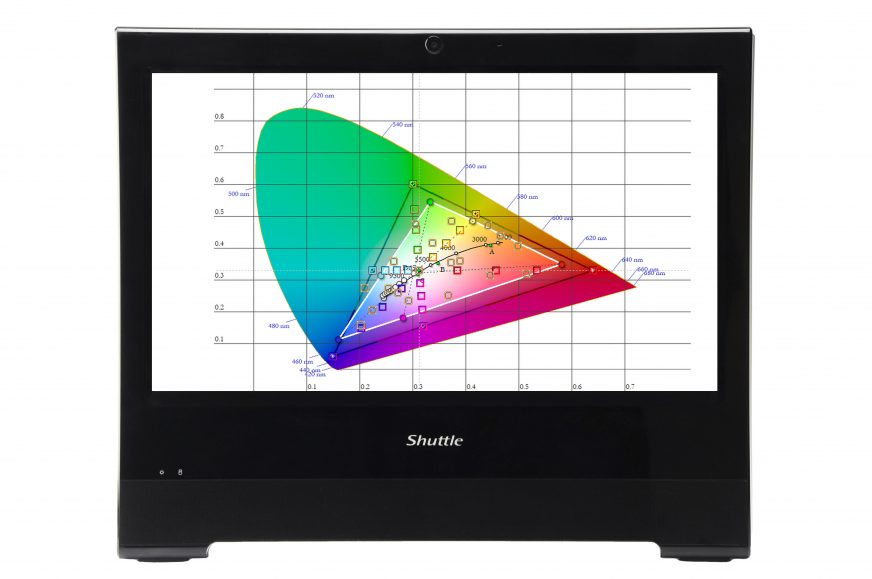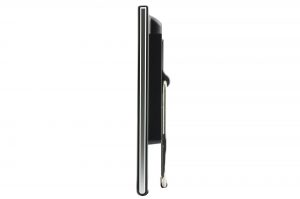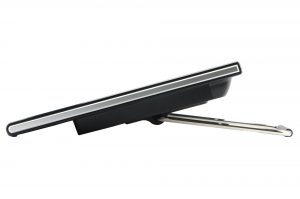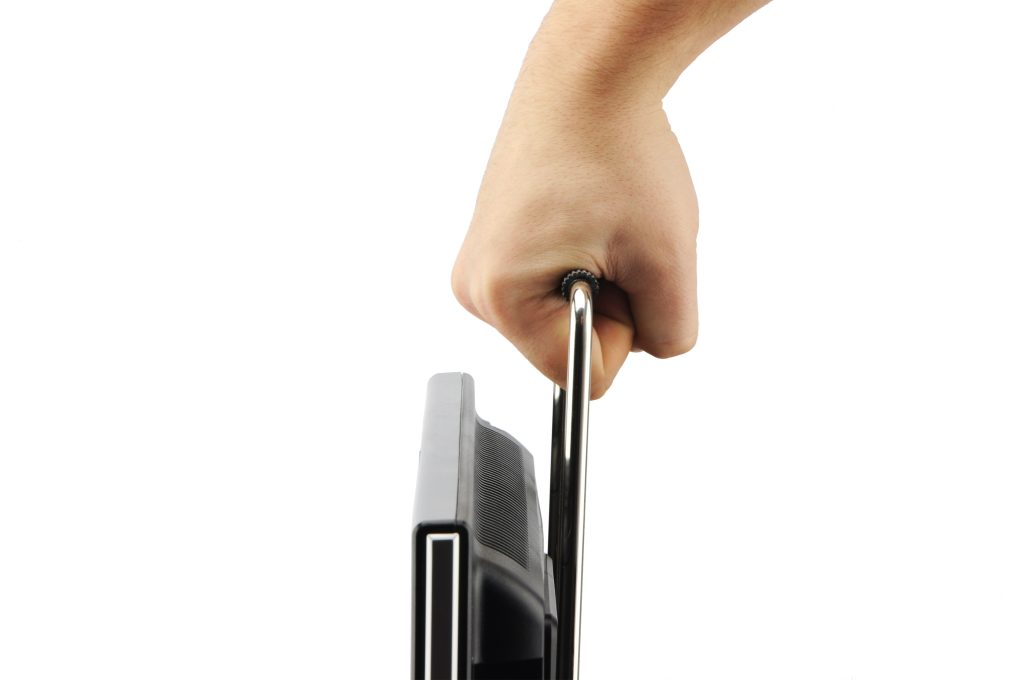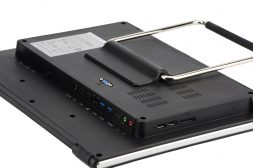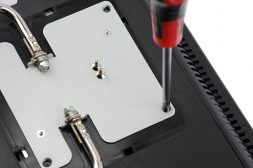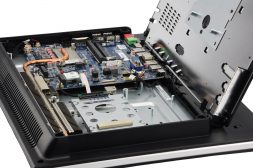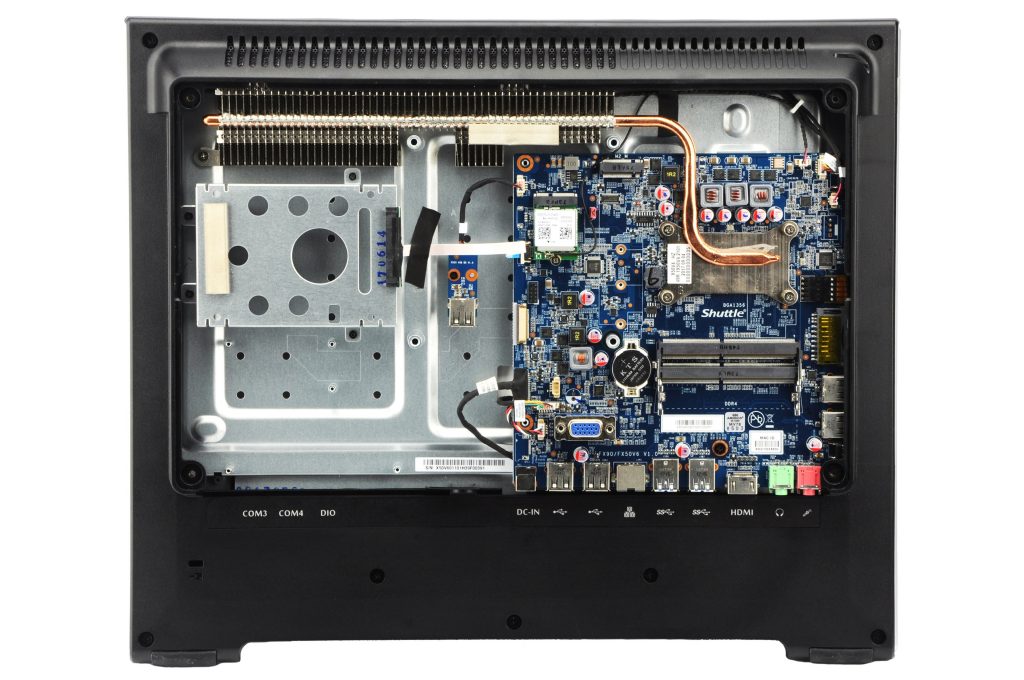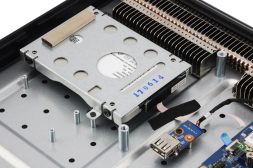Parameters, details, and assembly
There are not many cheap high-quality computers out there, so the design of XPC X50 is quite a pleasant surprise. It offers a lot of attractive features: display, robust mobile body, dust and liquid resistance, passive function, and the economical Kaby Lake. Shuttle managed to elegantly combine all of it into one handy device.
Basic parameters
| Shuttle XPC X50V6 (test configuration) | |
| CPU | Intel Celeron 3865U@1.8 GHz base clock |
| iGPU | Intel HD 610@300 MHz base clock | 900 MHz boost clock (max. resolution 4096 × 2304 px@60Hz) |
| RAM | optional 2× DDR3L or 2× DDR4 SO-DIMM |
| SSD/HDD | optional 1× M.2 (42 – 80 mm) or 1× 2,5" |
| Connectivity | ports | 2× USB 2.0, 2× USB 3.1 gen 1, 1× mSDxC, 2× 3,5mm audio jack, 1× HDMI 1.4b, 1× RJ-45 (1 Gb/s), WiFi 802.11b/g/n, DC in |
| LCD | 15,6" (1366 × 768 px) TN |
| Power supply adapter | 65 W (19 V | 3,42 A max.) |
| Measures (and weight) | 392 × 329 × 43 mm (3060 g without RAM and drives) |
| Approximate price | 386 eur |
Details and assembly
It is important to mention that Shuttle intended this computer to be a solution for cash registers, a computer for self-service Kiosk, or a mobile device for presentation rooms.
The design of the chassis is basically the same for every generation (this one is the sixth). Its appearance might not be appealing to everyone (some call it outdated), but the functional design is excellent. That’s probably the reason why it haven‘t changed over the years. Although it is a low-end case, it is really robust. It’s made of hard plastic, and the front panel is glossy but very easy to scratch. It’s also quite simple, except for a webcam and well-placed stereo speakers. By the way, they are decent. The sound output is not extraordinary, it‘s well balanced and clean.
There’s a massive steel arm with hinges at the rear panel. It works as a stand and as a holder for carrying. Its adjustment angle is wide enough. Handy, practical, and solid.
To get inside, you must first remove the decorative cover and the bracket underneath it. The lid is held by four screws. Access, assembly, and work with components is comfortable.
The processor and chipset share a common block which is connected to a well-designed heatsink via a heatpipe. PCB cooling under CPU voltage regulators is simply efficient. The heat is transferred by a thermal pad to a metal plate. It would be literally perfect if there was an anti-vibration mounting system for disks. There’s just one position for a 2.5″ drive, and one full-featured M.2 slot (80mm/NVMe). And there‘s also one external USB connector inside the case, which may come in handy when you want to use a Wi-Fi adapter.
However, the display (15.6″) is far from perfect. It may be satisfactory for declared purposes of XPC X50, but it is definitely not suitable for multimedia use. The static contrast is only 260:1, the resolution is low (1366 × 768 px), and the colours are poor (see the diagram in the title photo, measured with the X-rite iDisplay Pro calibration device). The blue channel is the worst, only the white channel is acceptable. One positive thing that can be said about the display is that there’s no clouding nor dark spots, the backlight is properly balanced.
The viewing angle is below average even for a TN display. The panel does not respond to pressure change, but otherwise it works just fine. The contact layer is resistant and its surface can “survive“ in areas with higher air humidity. The screen can react to greasy fingers without problems, and it can handle even rough cloth washing (when you have nothing else at hand). Its degree of protection is IP54.
The most troubling drawback is intensity of brightness. The maximum value we measured is only 148 cd/m2, which means bad visibility in a bright environment. You can reduce the brightness by linear steps up to 7.15 cd/m2. The difference in consumption between the maximum and minimum level is 2.4 W.
- Contents
- Parameters, details, and assembly
- Test procedures
- In idle
- Video decoding
- Image compression
- In burn (+ thermal images)
- Performance tests: transcoding and Mafia II
- Synthetics: Cinebench and 3DMark
- Conclusion





